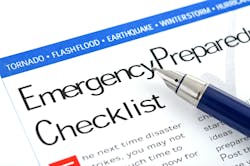Emergency Insights is a new column for Security Technology Executive in 2024.
Workplace emergency management is full of complexity and compliance. Most executives are ignorant of their duty of care to keep all personnel safe in their workplaces. Emergency Insights goal: Make America safer, one workplace at a time.
Year-end and year-beginnings always produce surveys forecasting top issues/priorities on management’s to-do list. 2023/2024 is no different.
The No. 1 issue heading into 2024 is workplace violence (WPV). No surprise here. The headlines are full of active shooters, angry demonstrations, and the murder rate—all high-anxiety videos impacting management nationwide.
What’s a CEO to do?
The research on this is clear. Many employers have Business Continuity Plans. Many employers have IT security plans. However, most employers have no Emergency Action Plan that complies with the law to protect employees. Millions spent on IT. Not even pennies were spent on employee emergency planning and training.
Success is achieved when your CEO has conducted a site-specific risk assessment. Then the creation of an Emergency Action Plan. Then the training of all personnel whether employees or embedded contractors.
None of these are easy or quick. It’s complex. It takes time and discipline. Add in people and cash resources.
Why? First, duty of care. The duty of care is not some foggy notion experts use to scare you into action. “…each employer shall furnish …a place of employment …free from recognized hazards that are causing or are likely to cause death or serious physical harm to employees.”
This is not a guideline. This is not a regulation. This is not a Hallmark Card you received when you took your job. This is a law passed by the United States Senate and House of Representatives and signed by the President of the United States in 1970. Almost unanimously at a time when that was an okay thing to do. Your duty of care is unambiguous, global, and absolute.
Second, you don’t need a law to want to do the right thing. Every CEO shouts that employee safety is their priority. But the wish is not the deed. The deed is the assessment, plan creation and training.
Workplace emergency management is filled with standards and regulations from your state/city fire code, OSHA, and your jurisdiction’s office of emergency management. Along with your local and state police and fire departments and more.
Conduct your site-specific risk assessment like you conduct your financial audits. Employ an outside, independent expert. Why? You don’t have the skills or expertise internally. Also, internal assessments are always compromised by politics and command influence. Thus, they are dismissed in court or by any third-party agency.
Can your PD and/or FD conduct your assessment? No. Your PD and FD are readily prepared to train you in what they do. Both are completely unprepared to assess, plan or train for how you respond in your unique workplace. If they were to assess you, then they would have to assess all workplaces. This is not the mission of your police and fire personnel.
Have a Plan
Next, create your Emergency Action Plan to include WPV. The U.S. Department of Justice research states that there are two million incidents of WPV annually. The DOJ believes WPV is under-reported by half. WPV is not just about active shooters. The DOJ sets the definition of WPV. Every working hour in America there are 26 rapes, 44 robberies, 207 aggravated assaults, 938 simple assaults, and 3,125 threats. All in our workplaces, not on the street.
Train Your Plan
Then, train your plan. Training is defined by law. You shall train all from the CEO down to the just-hired unpaid intern. You shall train in person in the classroom. You shall train at hire. You shall train by employing a “qualified” trainer—by experience or training. You should train all at least annually. In-person, classroom training can be supplemented by screen training. Screen training alone is illegal.
Do assessments, comprehensive plans and skilled training guarantee your staff will never be injured or killed by WPV? Negative. Emergency managers offer no guarantees. They do offer compliance. They do offer competence for you and your employees when that emergency strikes.
That’s your duty of care successfully embraced.
Bo was a Police Commissioner of Wilton, CT for 16 years. He retired to found 911 Consulting, which creates emergency, disaster recovery, business continuity, crisis communications and pandemic plans, and training and exercises for organizations like GE HQ, Hyatt HQ, H&R Block HQ, MasterCard HQ, four colleges and universities, and 29 secondary schools. He serves clients headquartered from Boston to Los Angeles working in their facilities from London to San Francisco. Bo also serves as an expert in landmark court cases nationally.
Given workplace violence may be your highest priority, ensure your plan covers an extensive list of WPV:
· Active Shooter
· Bomb Threat
· Workplace Bullying
· Suspicious Package
· Suspicious Person
· Civil Disobedience
· Stalking
· Assault
· Rape
· Explosion
· Hostage
· Lockdown
· Lockout
· Perimeter Security
· Protection Order
· Visitor Management
· Security After Hours
· Parking lot/Garage
· Suicide
· Weapons at Work
About the Author

Bo Mitchell
President of 911 Consulting
Bo Mitchell is the President of 911 Consulting. He holds the following designated certifications: CEM, CPP, CHS-V, CBCP, CSI-ML, HSEEP, CSSAS, CNTA, IAC, MOAB, CHSP, CHEP, CSHM, CESCO, CHCM, CFC, CSSM, CSC, CAS, TFCT3, CERT, CHSEMR, CMC
Bo was a Police Commissioner of Wilton, CT for 16 years. He retired to found 911 Consulting, which creates emergency, disaster recovery, business continuity, crisis communications and pandemic plans, and training and exercises for organizations like GE HQ, Hyatt HQ, H&R Block HQ, MasterCard HQ, four colleges and universities, and 29 secondary schools. He serves clients headquartered from Boston to Los Angeles working in their facilities from London to San Francisco. Bo also serves as an expert in landmark court cases nationally.

